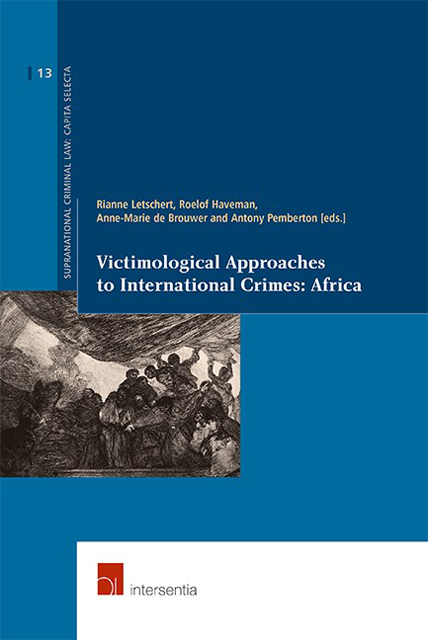Book contents
- Frontmatter
- Words of Appreciation
- Contents
- Introduction: Victimological Approaches to International Crimes
- Part I Victims of International Crimes
- Part II Reparative Justice
- PART III Amnesty, Truth, Reconciliation and Tradition
- Part IV International and National Legal and Policy Approaches
- Part V Victimological Approaches to International Crimes
- The Authors
- Bibliography
V - Primary and Secondary Victims and Victimization during Protracted Conflict: National Trauma through Literary Lens in Jerusalem and Kigali
Published online by Cambridge University Press: 24 November 2022
- Frontmatter
- Words of Appreciation
- Contents
- Introduction: Victimological Approaches to International Crimes
- Part I Victims of International Crimes
- Part II Reparative Justice
- PART III Amnesty, Truth, Reconciliation and Tradition
- Part IV International and National Legal and Policy Approaches
- Part V Victimological Approaches to International Crimes
- The Authors
- Bibliography
Summary
I am a woman from Rwanda.
I did not learn to write my ideas in books.
I lived in the spoken world.
But I met an author and he will tell my story.
Yolande MukagasanaINTRODUCTION
Over the last decades, with landmark international crimes such as the genocides in Bosnia and Rwanda, war crimes in Liberia, the former Yugoslavia, Sderot, Israel and Gaza, the Palestinian territories, and crimes against humanity in Darfur (Sudan), Eastern DR-Congo, Uganda and Sierra Leone, there has been increased awareness of victims and victimization in the context of international crime. Unlike the eff ects of conventional criminality, which involves a relatively small number of victims, international crimes result in mass victimization. Furthermore, the scope of its resulting victimization is broader, as international crimes tend to encompass several circles of victims and incorporate aspects of victimization that are not merely additive but multiplicative in their impact.
Whereas the issue of responsibility for international crimes and blameworthiness of individual perpetrators has been the subject of much discussion and scholarly attention, victims of international crimes have for a long time remained invisible and the extent and types of their injuries have not received the same level of consideration. Although the establishment of international criminal tribunals to address the crimes committed in the former Yugoslavia and Rwanda, and the creation of the International Criminal Court, have provided initial opportunities to study victims of international crimes, there are still gaps in our understanding of the variety of victims and extent of victimization in the context of protracted conflict.
In this chapter, we explore the ref ection of victimization in the context of international crime through the lens of writers who experienced or witnessed the crimes. Specifically, we compare how national trauma is narrated by Israeli and Rwandan writers, both of whom have written against a backdrop of genocide and holocaust. We first present the socio-political background of Israel and Rwanda, their similarities and divergence, making the case for the comparative analysis. We then provide a framework for conceptualizing victimization in an international context, extrapolating from conventional to international crimes. We address aspects of victimization related to international crimes that have been ignored in mainstream victimological research and discourse – the ways in which victimization and national trauma of innocent civil society is presented in its literature.
- Type
- Chapter
- Information
- Victimological Approaches to International Crimes: Africa , pp. 117 - 142Publisher: IntersentiaPrint publication year: 2011

